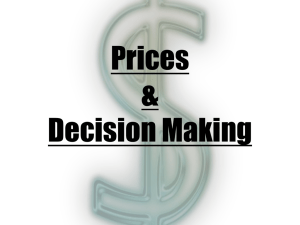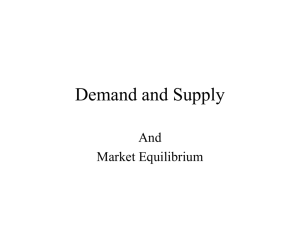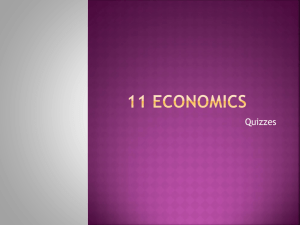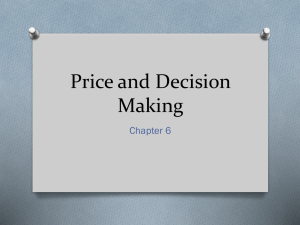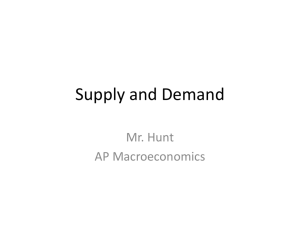Chapter 6 * Demand, Supply, and Prices
advertisement
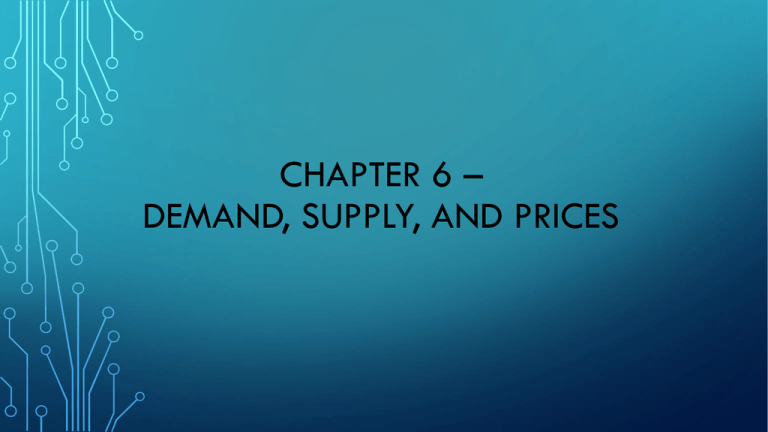
CHAPTER 6 – DEMAND, SUPPLY, AND PRICES SECTION 1 – SEEKING EQUILIBRIUM: DEMAND AND SUPPLY • Market Equilibrium – quantity demanded of a good/service at a particular price are equal • Equilibrium Price – price at which the quantity demanded and the quantity supplied are equal FIGURE 6.1 – KAREN’S MARKET DEMAND AND SUPPLY SCHEDULE • Karen wants to offer more salads at higher prices than at lower prices because she wants to earn more profit 1. What is the difference between quantity supplied and quantity demanded when the price is $10? What is the difference when the price is $2? 2. How does this market demand and supply schedule illustrate the laws of demand and supply? FIGURE 6.2 – MARKET DEMAND AND SUPPLY CURVE Showing the demand curve and the supply curve together on one graph, allows you to see the interaction of demand and supply graphically 1. What is the quantity supplied at $8? What is the quantity demanded at $8? 2. How do these market demand and supply curves illustrate the concept of equilibrium price? REACHING THE EQUILIBRIUM PRICE • Surplus – the result of quantity supplied being greater than quantity demanded • • • When there is a surplus, prices tend to fall until the surplus is sold and equilibrium is reached Producers might also choose to cut back their production to a quantity that is more in line with what consumers demand at the higher prices Shortage – the result of quantity demanded being greater than quantity supplied • When there is a shortage, producers raise prices in an attempt to balance quantity supplied and quantity demanded. • Producers may also try to increase quantity supplied to meet the quantities demanded at lower prices EQUILIBRIUM PRICE IN REAL LIFE • Disequilibrium – occurs when quantity demanded and quantity supplied are not in balance • Example – Holiday Toys, new phones, new shoes, etc. EQUILIBRIUM PRICE & CHANGES IN DEMAND AND SUPPLY If demand decreases If demand increases Supply increase OR OR Equilibrium price falls THEN supply decreases THEN Equilibrium price rises SECTION 2 – PRICES AS SIGNALS AND INCENTIVES • Competitive Pricing – occurs when producers sell products at lower prices to lure customers away from rival producers, while still making a profit • Examples: • • • Sales Coupons Give Aways CHARACTERISTICS OF THE PRICE SYSTEM • Is it neutral? • Both the producer and the consumer make choices that determine the equilibrium price • Is it market driven? • Market forces, not government policy, determine prices. In effect the system runs itself. • Is it flexible? • When market conditions change, so do prices. • Is it efficient? • Resources are allocated efficiently since prices adjust until the maximum number of goods and services are sold PRICES MOTIVATE PRODUCERS AND CONSUMERS • Incentive – encourages people to act in certain ways • Prices and Producers • for producers, the price system has two advantages • Provides information by acting as signals to producers about whether it is a good time to enter or leave a particular market • Rising prices and the expectation of profits motivate producers to enter a market • A shortage in a market is a signal that consumer demand is not being met by existing suppliers and producers see an opportunity to raise prices • While prices are the signals that are visible in the market, it is the expectation of profits or the possibility of losses that motivates producers to enter or leave a market • Prices and Consumers • Surpluses that lead to lower prices tell consumers that it is a good time to buy a particular good or service – often sent to consumers through advertising and story displays • High prices generally discourage consumers from buying a particular product and may signal that it is time to buy a substitute at a lower price SECTION 3 – INTERVENTION IN THE PRICE SYSTEM • Price Ceiling – the legal maximum price that sellers may charge for a product • Price Floor – the legal minimum price that sellers may charge for a product • Rationing – a government system for allocating goods and services using criteria other than price • Black Market – involves illegally buying or selling in violation of price controls or rationing • Why is a price ceiling set below equilibrium price rather than above it? • The intent is to keep the price from rising too high when equilibrium is considered too high What negative incentives does rent control pricing give to producers and consumers? SETTING PRICE FLOORS • Sometimes the government needs to intervene in the price system to increase income to certain producers • Example: Farmers – set prices for corn, milk, etc. • Example: Minimum Wage • If minimum wage is set above the equilibrium price for certain jobs in a market, employers may decide that paying the higher wages is not profitable. As a result, they may choose to employ fewer works, and unemployment will increase. • If minimum wage is set below the equilibrium price, then it will have no effect RATIONING RESOURCES AND PRODUCTS • Sometimes in periods of national emergency the government decides to ration scarce products or resources • Generally, a system is set up that uses coupons allowing each person a certain amount of a particular item • Government may decree that certain resources will not be rationed but used to produce other goods – this creates the black market • Office of Price Administration – established 1941- ration scare goods • The hope was that these goods would be distributed to everyone, not just those who could afford the higher market prices born of shortages • Allocated resources in ways that favored the war effort rather than the consumer market • Rationing led consumers to look for substitutes • Margarine vs. Butter • Black Markets – come into existence when rationing is imposed • Prices are very high

